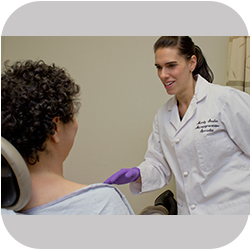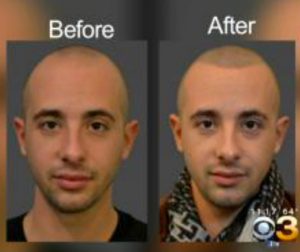Unique Jobs at HUP
Most health-care jobs have  a clear connection to medicine but others are not quite so obvious. Read below to see how a tattoo artist uses her skills to help cancer patients.
a clear connection to medicine but others are not quite so obvious. Read below to see how a tattoo artist uses her skills to help cancer patients.
When Mandy Sauler starting doing tattoos in her mother’s shop nearly 20 years ago, she never thought this skill would lead her to helping women recovering from breast cancer…. But that’s exactly what happened. As HUP’s micropigmentation specialist, she provides the final step for many women who underwent mastectomy and reconstructive surgeries, tattooing areolas to create a realistic three- dimensional appearance.
Many factors combine to make a natural-looking areola, Sauler explained. If the patient has a unilateral reconstruction, Sauler matches the tattooed areola with that of the remaining breast. But, with a dual reconstruction, she discusses with patients the best size and coloring for them now. For all tattoos, “I draw it on first to see how it looks in the mirror,” she said. “Then I mix up colors based on their skin tone and see how it looks on the patient’s skin.”
Once she and the patient are satisfied, she begins the tattoo process, using different-sized needles and multiple colors to create the desired effect. Although most women don’t feel any pain, “I can use topical anesthetic,” she said. Most tell her, “It wasn’t as bad as I thought.”
Some patients have a nipple created surgically but, for others, Sauler can create the illusion of a 3-dimensional nipple, which looks extremely lifelike. One woman wrote her a letter about when she went for a mammogram for her “new” breast: “The clinician, who does 20 to 30 mammograms a day, pulls a ‘marker’ off a strip and plants it right on the tattoo you gave me (my new nipple)…. The woman thought it was a genuine nipple at first glance.… I said, ‘That’s a tattoo’ and she was floored! She said that’s she’d never been fooled before. A heartfelt thanks for a job well done!”
When the process is completed, “I stand behind the patient as she looks in the mirror. Looking at their faces – it makes me feel so good. No one has a better job than I do.”
Sauler began her early training working on oranges. “I was eager to learn so my mom would have me practice on oranges or grapefruits. At the time, they were perfect because of the thickness of the skin and they’re round, like the curvature on most body parts,” she said. When she was 14, “I started saving the tattoos – in the freezer – to show friends!” Today, she said, tattoo artists can learn on fake skin or mannequins, which were not available back then.
To become skilled in medical tattoos, Sauler trained “with a medical tattoo artist who is also a painter,” she said. Medical tattooing has become a little more common, but early on, medical offices were given a machine to create the areola “which had some basic skin colors but they received no training. It looked like a flat circle,” she said “Now people realize it’s an art. I think it takes a least three years before a person can be comfortable working on skin – and be good at it.”
Sauler uses her skill to help other types of patients as well. For example, she can create eyebrows to frame the eye for patients with alopecia (which causes hair loss on some or all of the body). She can also camouflage scars. She recalled one person whose leg was seriously burned when she was a toddler and had always worn slacks to hide the scar. “Over time scars hypopigmate, which means they turn lighter,” she explained. Using multiple colors, Sauler camouflaged the scar. “She told me that she can now wear skirt and stockings.”
Do You Have A Unique Job?
Do you — or someone you know at HUP — have a job that seems unique in a health-care setting? If so, please let me know. Email sally.sapega@uphs.upenn.edu.
Photo caption: Mandy Sauler carefully creates an areola tattoo on breast cancer patient Ginka Nikolov.




 Hair
Hair

